Quarter Century Development of Laser Peening without Coating
Abstract
:1. Introduction
2. Fundamental Process of LPwC
3. Effects of LPwC
3.1. Effects on Residual Stress
3.2. Effects on Fatigue Properties
3.3. Effects on SCC Susceptibility and Application to NPRs
4. Palmtop-Sized Handheld Laser Development
- Higher reliability and operability can be expected due to simplicity of the system, which requires fewer personnel for the operation and maintenance.
- The system is much tolerant toward ambient conditions, i.e., temperature change, vibration, etc., resulting from the smaller system volume and number of parts.
- Required laser power can be decreased due to smaller transmitting loss of laser energy resulting from the shorter optical path and simpler optics.
- Application to infrastructure such as NPRs, bridges, windmills, etc. could be easier due to the smaller and simpler system.
5. Concluding Remarks
Funding
Conflicts of Interest
References
- Sano, Y.; Kimura, M.; Sato, K.; Obata, M.; Sudo, A.; Hamamoto, Y.; Shima, S.; Ichikawa, Y.; Yamazaki, H.; Naruse, M.; et al. Development and Application of Laser Peening System to Prevent Stress Corrosion Cracking of Reactor Core Shroud. In Proceedings of the 8th International Conference on Nuclear Engineering (ICONE-8), Baltimore, MD, USA, 2–6 April 2000. [Google Scholar]
- Yoda, M.; Chida, I.; Okada, S.; Ochiai, M.; Sano, Y.; Mukai, N.; Komotori, G.; Saeki, R.; Takagi, T.; Sugihara, M.; et al. Development and Application of Laser Peening System for PWR Power Plants. In Proceedings of the 14th International Conference on Nuclear Engineering (ICONE-14), Miami, FL, USA, 17–20 July 2006. [Google Scholar]
- Sano, Y.; Mukai, N.; Okazaki, K.; Obata, M. Residual stress improvement in metal surface by underwater laser irradiation. Nucl. Instrum. Methods Phys. Res. B 1997, 121, 432–436. [Google Scholar] [CrossRef]
- Schmidt-Uhlig, T.; Karlitschek, P.; Marowsky, G.; Sano, Y. New simplified coupling scheme for the delivery of 20 MW Nd: YAG laser pulses by large core optical fibers. Appl. Phys. B 2001, 72, 183–186. [Google Scholar] [CrossRef]
- Schmidt-Uhlig, T.; Karlitschek, P.; Yoda, M.; Sano, Y.; Marowsky, G. Laser shock processing with 20 MW laser pulses delivered by optical fibers. Eur. Phys. J. AP 2000, 9, 235–238. [Google Scholar] [CrossRef]
- Sano, Y.; Tamura, M.; Chida, I.; Suezono, N. Underwater Maintenance and Repair Technologies for Reactor Components by Laser Material Processing. In Proceedings of the 7th International Welding Symposium (7WS), Kobe, Japan, 20–22 November 2001. [Google Scholar]
- Sano, Y.; Kimura, M.; Yoda, M.; Mukai, N.; Sato, K.; Uehara, T.; Ito, T.; Shimamura, M.; Sudo, A.; Suezono, N. Development of Fiber-Delivered Laser Peening System to Prevent Stress Corrosion Cracking of Reactor Components. In Proceedings of the 9th International Conference on Nuclear Engineering (ICONE-9), Nice, France, 8–12 April 2001. [Google Scholar]
- Akita, K.; Sano, Y.; Takahashi, K.; Tanaka, H.; Ohya, S. Strengthening of Si3N4 ceramics by laser peening. Mater. Sci. Forum 2006, 524–525, 141–146. [Google Scholar] [CrossRef]
- Saigusa, K.; Takahashi, K.; Sibuya, N. Evaluation of surface properties of silicon nitride ceramics treated with laser peening. Int. J. Peen. Sci. Technol. 2019, 1, 221–232. [Google Scholar]
- Sano, Y.; Obata, M.; Kubo, T.; Mukai, N.; Yoda, M.; Masaki, K.; Ochi, Y. Retardation of crack initiation and growth in austenitic stainless steels by laser peening without protective coating. Mater. Sci. Eng. A 2006, 417, 334–340. [Google Scholar] [CrossRef]
- Sakino, Y.; Sano, Y.; Kim, Y.-C. Application of laser peening without coating on steel welded joints. Int. J. Struct. Integ. 2011, 2, 332–344. [Google Scholar] [CrossRef]
- Masaki, K.; Ochi, Y.; Matsumura, T.; Ikarashi, T.; Sano, Y. Effects of laser peening treatment on high cycle fatigue and crack propagation behaviors in austenitic stainless steel. J. Power Energy Syst. 2010, 4, 94–104. [Google Scholar] [CrossRef] [Green Version]
- Sano, Y.; Masaki, K.; Gushi, T.; Sano, T. Improvement in fatigue performance of friction stir welded A6061-T6 aluminum alloy by laser peening without coating. Mater. Des. 2012, 36, 809–814. [Google Scholar] [CrossRef]
- Maawad, E.; Sano, Y.; Wagner, L.; Brokmeier, H.-G.; Genzel, C. Investigation of laser shock peening effects on residual stress state and fatigue performance of titanium alloys. Mater. Sci. Eng. A 2012, 536, 82–91. [Google Scholar] [CrossRef]
- Altenberger, I.; Sano, Y.; Nikitin, I.; Scholtes, B. Fatigue Behavior and Residual Stress State of Laser Shock Peened Materials at Ambient and Elevated Temperatures. In Proceedings of the 9th International Fatigue Congress (FATIGUE 2006), Atlanta, GA, USA, 14–19 May 2006. [Google Scholar]
- Sakino, Y.; Sano, Y. Investigations for lowering pulse energy of laser-peening for improving fatigue strength. Q. J. Jpn. Weld. Soc. 2018, 36, 153–159. [Google Scholar] [CrossRef] [Green Version]
- Ubiquitous Power Laser for Achieving a Safe, Secure and Longevity Society under ImPACT Program. Available online: https://www.jst.go.jp/impact/sano/index.html (accessed on 31 December 2019).
- Mukai, N.; Aoki, N.; Obata, M.; Ito, A.; Sano, Y.; Konagai, C. Laser Processing for Underwater Maintenance in Nuclear Plants. In Proceedings of the 3rd JSME/ASME International Conference on Nuclear Engineering (ICONE-3), Kyoto, Japan, 23–27 April 1995. S404-3. [Google Scholar]
- Fabbro, R.; Peyre, P.; Berthe, L.; Scherpereel, X. Physics and applications of laser-shock processing. J. Laser Appl. 1998, 10, 265–279. [Google Scholar] [CrossRef]
- Peyre, P.; Chaieb, I.; Braham, C. FEM calculation of residual stresses induced by laser shock processing in stainless steels. Model. Simul. Mater. Sci. Eng. 2007, 15, 205–221. [Google Scholar] [CrossRef]
- Fairand, B.P.; Clauer, A.H.; Jung, R.G.; Wilcox, B.A. Quantitative assessment of laser-induced stress waves generated at confined surfaces. Appl. Phys. Lett. 1974, 25, 431–433. [Google Scholar] [CrossRef]
- Sokol, D.W.; Clauer, A.H.; Ravindranath, R. Applications of Laser Peening to Titanium Alloys. In Proceedings of the ASME/JSME 2004 Pressure Vessels and Piping Division Conference, San Diego, CA, USA, 25–29 July 2004. [Google Scholar]
- Sano, Y.; Kimura, M.; Mukai, N.; Yoda, M.; Obata, M.; Ogisu, T. Process and Application of Shock Compression by Nano-Second Pulses of Frequency-Doubled Nd: YAG Laser. In Proceedings of the International Forum on Advanced High-Power Lasers and Applications (AHPLA’99), Osaka, Japan, 1–5 November 1999. [Google Scholar]
- Sano, Y.; Mukai, N.; Yoda, M.; Ogawa, K.; Suezono, N. Underwater laser shock processing to introduce residual compressive stress on metals. Mater. Sci. Res. Int. 2001, 2, 453–458. [Google Scholar]
- Sano, Y.; Yoda, M.; Mukai, N.; Obata, M.; Kanno, M.; Shima, S. Residual stress improvement mechanism on metal material by underwater laser irradiation. J. Atom. Energy Soc. Jpn. 2000, 42, 567–573. [Google Scholar] [CrossRef] [Green Version]
- Fabbro, R.; Fournier, J.; Ballard, P.; Devaux, D.; Virmont, J. Physical Study of Laser-produced Plasma in Confined Geometry. J. Appl. Phys. 1990, 68, 775–784. [Google Scholar] [CrossRef]
- Sano, Y. A Finite Element Method for Contact Problems between Three-Dimensional Curved Bodies. J. Nucl. Sci. Technol. 1996, 33, 119–127. [Google Scholar] [CrossRef]
- Ochi, Y.; Masaki, K.; Matsumura, T.; Wakabayashi, Y.; Sano, Y.; Kubo, T. Effects of Laser Peening on High Cycle Fatigue Properties in Austenitic Stainless Steel. In Proceedings of the 12th International Conference on Experimental Mechanics (ICEM12), Bari, Italy, 29 August–2 September 2004. [Google Scholar]
- Sakino, Y.; Sano, Y.; Sumiya, R.; Kim, Y.-C. Major factor causing improvement in fatigue strength of butt welded steel joints after laser peening without coating. Sci. Technol. Weld. Join. 2012, 17, 402–407. [Google Scholar] [CrossRef]
- Sano, Y.; Sakino, Y.; Mukai, N.; Obata, M.; Chida, I.; Uehara, T.; Yoda, M.; Kim, Y.-C. Laser peening without coating to mitigate stress corrosion cracking and fatigue failure of welded components. Mater. Sci. Forum 2008, 519, 580–582. [Google Scholar] [CrossRef]
- Adachi, T.; Takehisa, H.; Nakajima, M.; Sano, Y. Effect of Laser Peening on Fatigue Properties for Aircraft Structure Parts. In Proceedings of the 10th International Conference on Shot Peening (ICSP10), Tokyo, Japan, 15–18 September 2008. [Google Scholar]
- Sano, Y.; Obata, M.; Yamamoto, T. Residual stress improvement of weldment by laser peening. Weld. Int. 2006, 20, 598–601. [Google Scholar] [CrossRef]
- Sakino, Y.; Yoshikawa, K.; Sano, Y.; Sumiya, R.; Kim, Y.-C. A basic study for application of laser peening to large-scale steel structure. Q. J. Jpn. Weld. Soc. 2013, 31, 231–237. [Google Scholar] [CrossRef] [Green Version]
- Zheng, L.; Kausas, A.; Taira, T. Drastic thermal effects reduction through distributed face cooling in a high power giant-pulse tiny laser. Opt. Mater. Exp. 2017, 7, 3214–3221. [Google Scholar] [CrossRef]
- Ubiquitous Power Laser for Achieving a Safe, Secure and Longevity Society under ImPACT Program. Available online: https://www.youtube.com/watch?v=nMsOkkEPK5I (accessed on 31 December 2019).

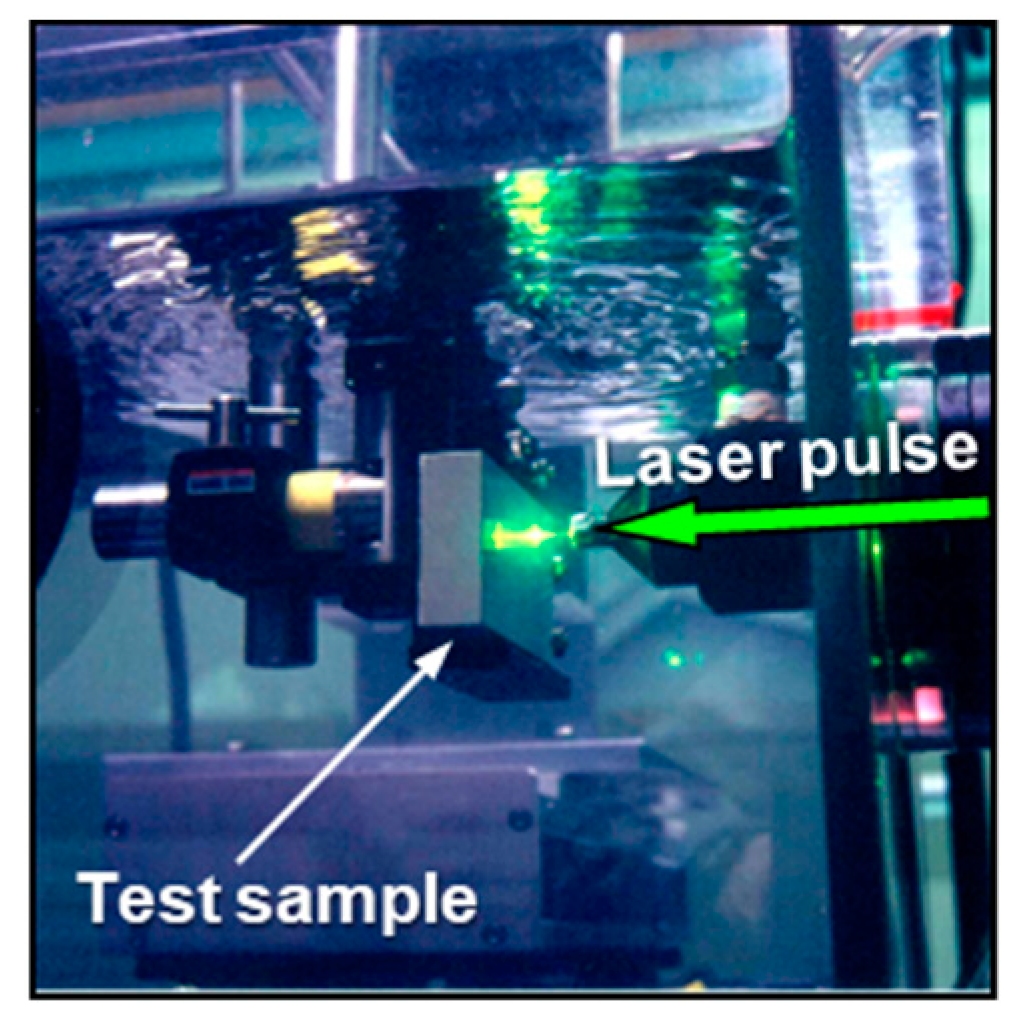



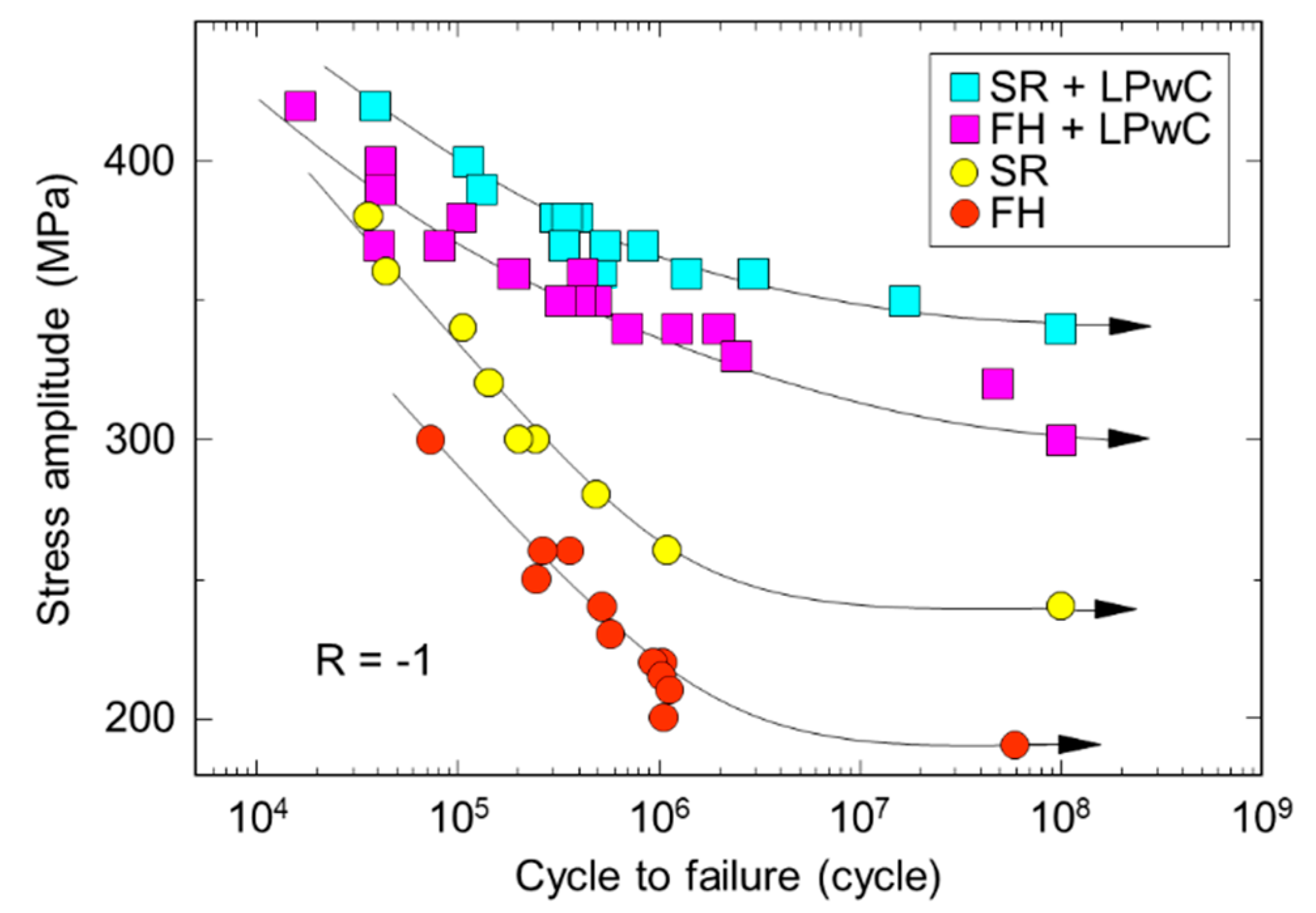
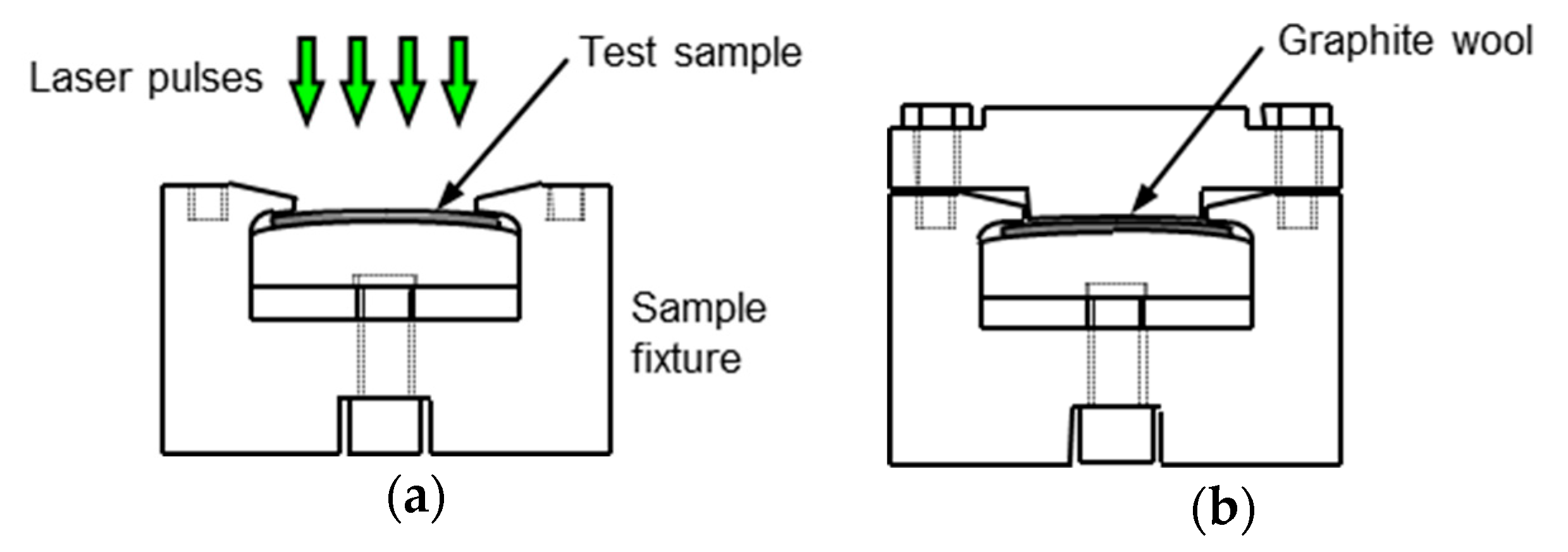



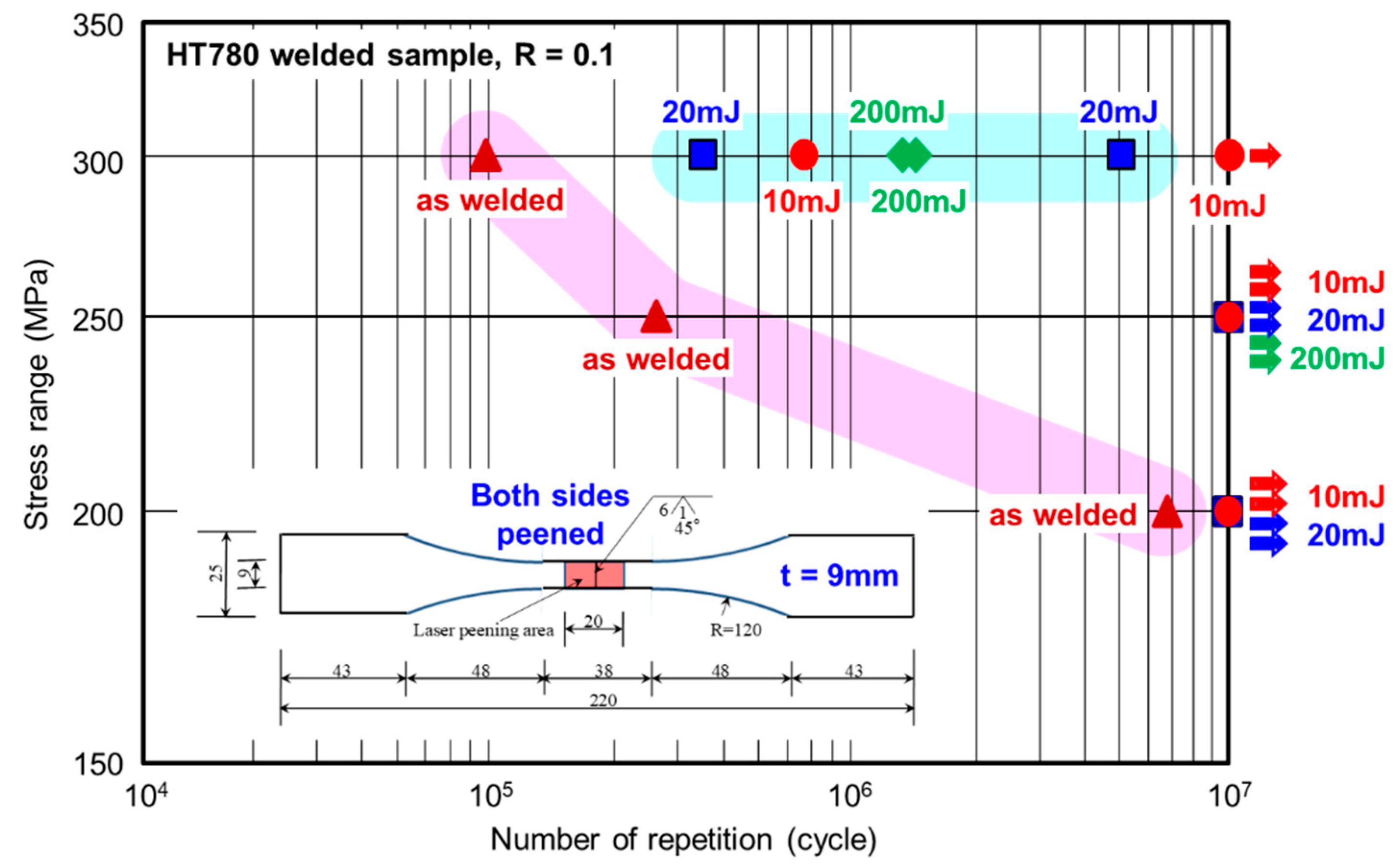

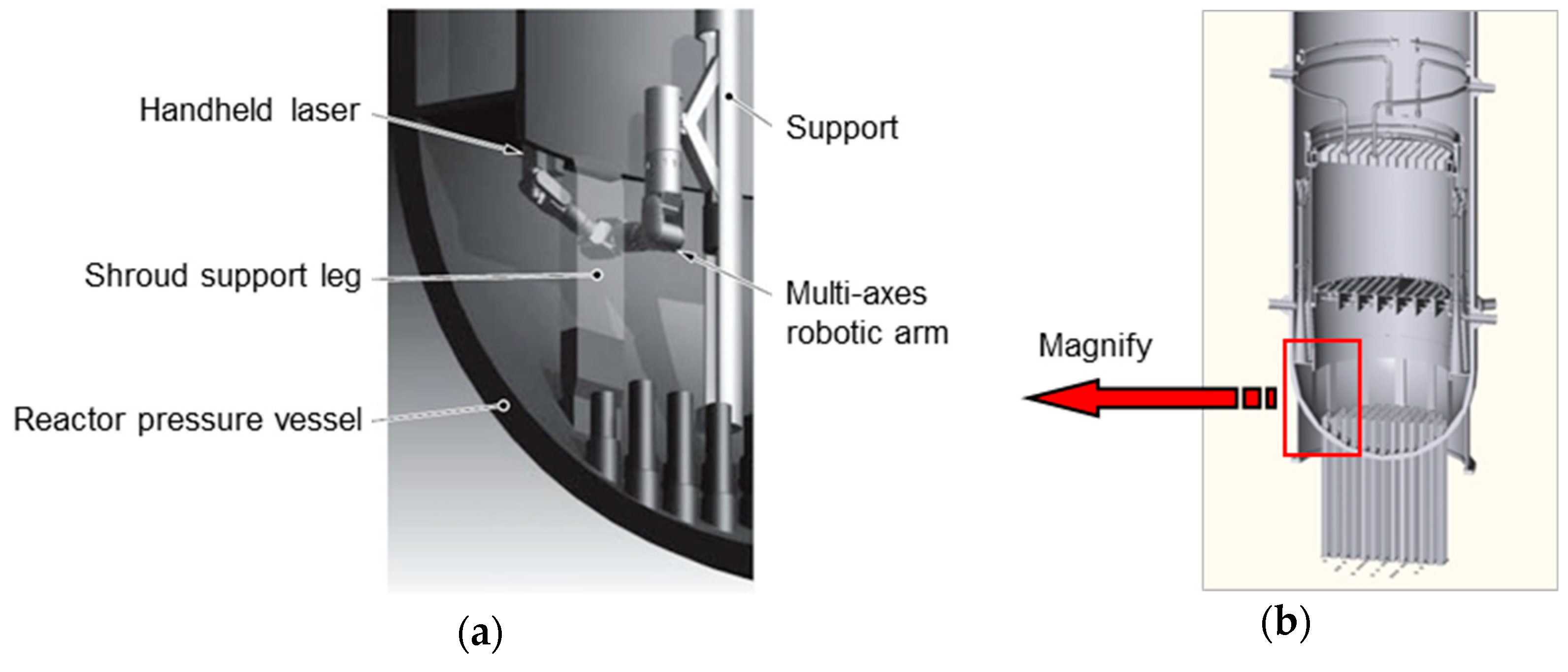
© 2020 by the author. Licensee MDPI, Basel, Switzerland. This article is an open access article distributed under the terms and conditions of the Creative Commons Attribution (CC BY) license (http://creativecommons.org/licenses/by/4.0/).
Share and Cite
Sano, Y. Quarter Century Development of Laser Peening without Coating. Metals 2020, 10, 152. https://doi.org/10.3390/met10010152
Sano Y. Quarter Century Development of Laser Peening without Coating. Metals. 2020; 10(1):152. https://doi.org/10.3390/met10010152
Chicago/Turabian StyleSano, Yuji. 2020. "Quarter Century Development of Laser Peening without Coating" Metals 10, no. 1: 152. https://doi.org/10.3390/met10010152




